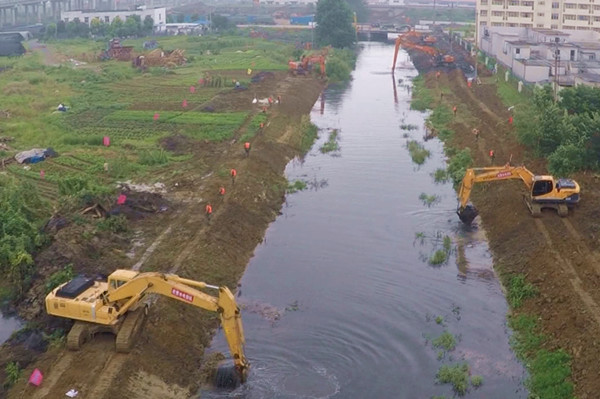|
 |
|
Armed police in Anqing city help farmers save vegetables from flood damage on June 26. Photo by Liu Kegang |
East China’s Anhui province, with 70 million residents in 16 prefecture-level cities, has experienced devastating floods but the launch of a long-anticipated high-speed railway will provide huge benefits and gives reason for renewed hope.
As heavy rain from June 26 to July 2 led to severe flooding that killed at least seven people and submerged 466,500 hectares of crops, the opening of the 800-kilometer-long high-speed railway between Anhui and Fujian provinces was a major boost to Anhui’s transport and tourism sector.
The provincial department of civil affairs said 4.33 million people in 13 cities were affected by the floods that caused 3.76 billion yuan ($596 million) in direct economic loss, as 3,633 houses collapsed and 39,370 other homes were damaged.
Six people were confirmed dead, with one other missing, in Jinxian county while another flood death was confirmed in Huoqiu county. Both counties are located among the Dabie Mountains in western Anhui.
On June 28, when water levels in rivers, lakes and reservoirs swelled, Anhui’s Party chief Wang Xuejun and Acting Governor Li Jinbin came to the Provincial Flood Control and Drought Relief Headquarters for updates on flood control and offered guidance on relief work.
|
 |
|
Armed police in Anqing city help dredge the Dazhaigou watercourse on July 5 following floods in the city. Photo by Liu Kegang |
Wang called on the relief teams to prioritize people’s safety and spare no effort in tackling the floods and carrying out disaster relief work. With major rivers, including the Yangtze and Huaihai, zigzagging their ways across the province, Anhui is prone to floods as the summer rainfall - which usually accounts for about half of the year’s total - hits the mountainous regions and riverside areas.
Despite the floods, Anhui residents still warmly embraced the operation of the Hefei-Fuzhou high-speed railway between the capitals of Anhui and Fujian provinces, on June 28 which halved the travel time between them from eight to four hours. Four days later, the longer high-speed railway between Beijing and Fuzhou, of which the Hefei-Fuzhou high-speed railway is a major section, also started operation.
Often described as the “most scenic" high-speed rail in China, the Hefei-Fuzhou section, which started construction in 2009, presented a major engineering challenge in terms of terrain. More than 85 percent of the track had to be laid on bridges or in tunnels, said Ye Bingcheng, chief designer of the railway.
Since the country's first bullet train left the assembly line in 2008, high-speed rail has expanded vigorously, with more than 16,000 kilometers of fast track in operation and another 10,000 kilometers under construction.